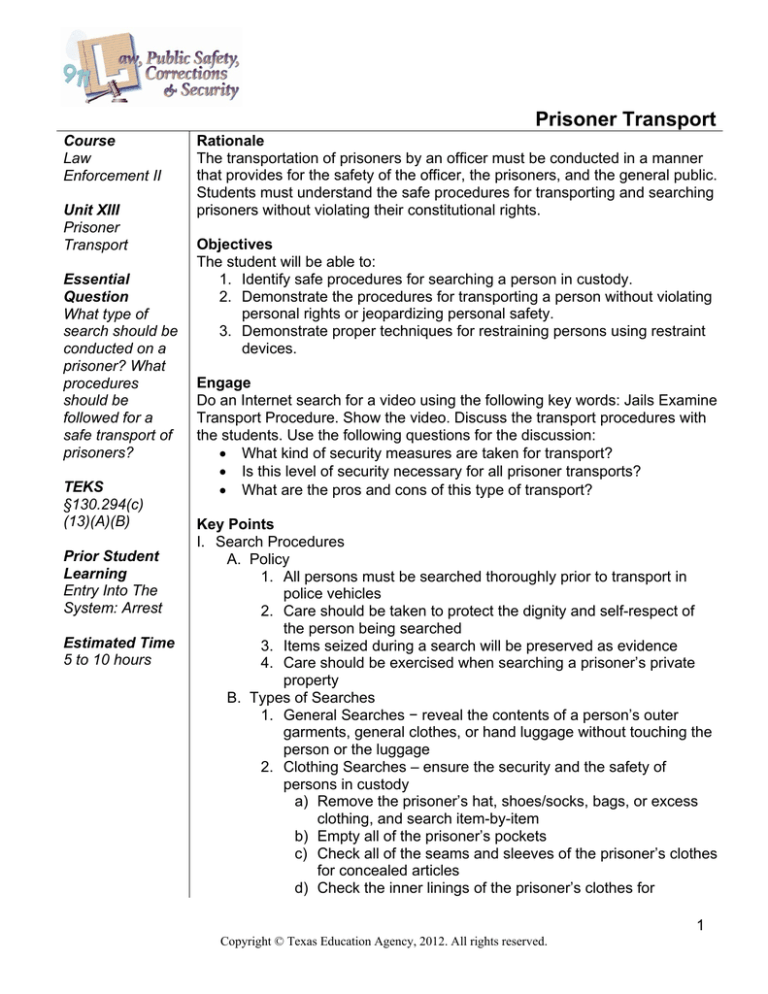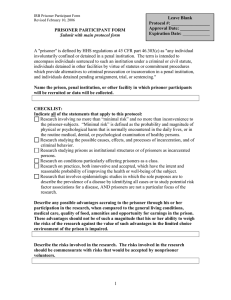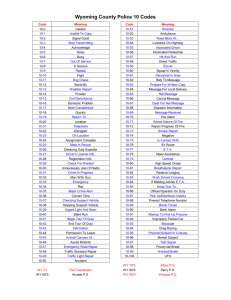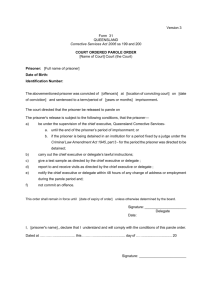Prisoner Transport
advertisement

Prisoner Transport Course Law Enforcement II Unit XIII Prisoner Transport Essential Question What type of search should be conducted on a prisoner? What procedures should be followed for a safe transport of prisoners? TEKS §130.294(c) (13)(A)(B) Prior Student Learning Entry Into The System: Arrest Estimated Time 5 to 10 hours Rationale The transportation of prisoners by an officer must be conducted in a manner that provides for the safety of the officer, the prisoners, and the general public. Students must understand the safe procedures for transporting and searching prisoners without violating their constitutional rights. Objectives The student will be able to: 1. Identify safe procedures for searching a person in custody. 2. Demonstrate the procedures for transporting a person without violating personal rights or jeopardizing personal safety. 3. Demonstrate proper techniques for restraining persons using restraint devices. Engage Do an Internet search for a video using the following key words: Jails Examine Transport Procedure. Show the video. Discuss the transport procedures with the students. Use the following questions for the discussion: What kind of security measures are taken for transport? Is this level of security necessary for all prisoner transports? What are the pros and cons of this type of transport? Key Points I. Search Procedures A. Policy 1. All persons must be searched thoroughly prior to transport in police vehicles 2. Care should be taken to protect the dignity and self-respect of the person being searched 3. Items seized during a search will be preserved as evidence 4. Care should be exercised when searching a prisoner’s private property B. Types of Searches 1. General Searches − reveal the contents of a person’s outer garments, general clothes, or hand luggage without touching the person or the luggage 2. Clothing Searches – ensure the security and the safety of persons in custody a) Remove the prisoner’s hat, shoes/socks, bags, or excess clothing, and search item-by-item b) Empty all of the prisoner’s pockets c) Check all of the seams and sleeves of the prisoner’s clothes for concealed articles d) Check the inner linings of the prisoner’s clothes for 1 Copyright © Texas Education Agency, 2012. All rights reserved. evidence of damage or tampering e) Remove the loose inner soles of the prisoner’s shoes f) Bang the prisoner’s shoes together to loosen any hidden items g) Turn the prisoner’s socks inside out 3. Strip Searches – require the removal of some or all of the prisoner’s clothing to reveal contraband a) If a strip search is required, the search must be conducted only in a private area of the detention center of the medical facility b) The prisoner must be allowed to remain partially clothed at all times c) The search must be carried out as quickly as possible d) The search must be conducted by a staff member of the same sex as the prisoner 4. Personal Searches a) Check the prisoner’s hair, especially women with ponytails or weaves, to ensure nothing is hidden in their hair b) Inspect the prisoner’s mouth and ears c) Search the seams on the collar of the prisoner’s clothing d) Apply light pressure, with the palms of your hands and pat over the prisoner’s torso paying particular attention to the recess of the spine until reaching the beltline e) Run the up side of your palms (palms down/bladed hand) in between and underneath the breasts of female prisoners f) Sweep the fingers around the prisoner’s waistline and underneath the prisoner’s belt g) Ensure that the prisoner’s pockets are patted thoroughly h) With straight fingers, run your hand into the crotch area of male offenders, being careful not to grope the prisoner’s genitals i) Ensure that the prisoner’s pant cuffs are unrolled and patted II. Transport of Prisoners A. Vehicle Checklist 1. Every patrol vehicle shall be searched by the assigned officer at the beginning of that officer’s shift a) Search the vehicle before and after transporting a prisoner b) Search the rear seat area prior to placing a prisoner in the vehicle c) Check the passenger compartment after transport for any contraband dropped by the prisoner during transport d) Treat the items left in the vehicle as evidence until determined otherwise B. Transport Guidelines 1. A maximum of two prisoners may be transported in a patrol car 2 Copyright © Texas Education Agency, 2012. All rights reserved. 2. Juveniles can only be transported in patrol cars 3. No adult may be transported with a juvenile except a parent or other adult arrested in connection with same offense 4. Female prisoners may be transported with male prisoners only when they are arrested during the same incident C. Special Circumstances 1. A Prisoner Becomes Disorderly a) Continue to the detention facility if the prisoner does not pose a threat to the safe operation of the vehicle b) Pull over to side of road and notify dispatch if safe operation of the vehicle is at risk. Exit the vehicle and wait for help to arrive. Do not open the doors 2. Prisoner Communication a) The prisoner shall not communicate with anyone during transport, other than transporting officer 3. Visual Observation a) The transporting officer should be able to visually observe the prisoner at all times b) Extreme care should be taken on extended trips when stopping for fuel, meals, or personal relief c) An officer of the same sex should be used if transport is lengthy 4. Transport to a hospital or medical facility a) Isolate the prisoner from other patients b) Never leave the prisoner unattended c) Notify hospital security d) Remove restraints only if necessary for medical care e) Prisoners who are sick or injured shall be examined by Emergency Medical Services (EMS) prior to transport f) If necessary, EMS may call an ambulance for the transport of the prisoner to a medical facility. The officer will follow the ambulance, unless he or she is requested to ride with the prisoner by ambulance personnel g) While being transported, a sick or injured prisoner shall be handcuffed h) An unconscious prisoner shall be transported by ambulance to a hospital or medical facility 5. Physically and mentally handicapped prisoners a) Prisoners requiring wheelchairs, crutches, or prosthetic appliances should be given special consideration when transported b) The seriousness of the handicap, the mobility of the prisoner, and the circumstances of the arrest will determine the degree of physical restraint used c) Mentally disturbed prisoners are to be restrained securely without causing injury. If the prisoner is violent, two or more 3 Copyright © Texas Education Agency, 2012. All rights reserved. officers will be used to transport the prisoner d) If a mentally ill prisoner exhibits violent or bizarre behavior that may cause harm to himself or herself, or others, the prisoner may be transported on a stretcher in an ambulance D. Restraints 1. All prisoners must be handcuffed, and handcuffs must be double locked 2. When necessary, a prisoner may be restrained with a waist belt of leg shackles 3. No person shall be handcuffed to a stationary object or to any part of the transporting vehicle, or be left unattended 4. Officers will check the tightness of handcuffs after they are applied a) Officers should be able to slip an index finger under the handcuffs on the top, bottom and sides 5. Officers should investigate the prisoner’s complaints that the handcuffs are too tight a) Loosen the handcuffs if needed b) Document the action taken in response to the prisoner’s complaint 6. Handcuffs will not be removed until the prisoner is inside the detention facility 7. Officers will not use the “hog tie” method of maximum restraint to control an unruly prisoner 8. An officer will not handle another police incident while transporting a prisoner unless it is of the magnitude to place a life in jeopardy III. Handcuffing A. Safety 1. Remember that handcuffs can be used as a weapon 2. Keep the handcuffs closed at all times 3. Maintain full control of the handcuffs 4. Keep your thumb out of the way of the arm bar 5. Double lock the handcuffs after applying them B. Nomenclature 1. Chain 2. Ratchet 3. Teeth 4. Lock C. Positioning 1. Handcuffing should be initiated from the 2½ tactical position a) The officer should be behind the suspect with the gun side away from the suspect b) The officer’s inside shoulder should line up with the suspect’s outside shoulder 4 Copyright © Texas Education Agency, 2012. All rights reserved. D. Verbal Commands 1. “Suspect, bend over at the waist” a) Make sure that the suspect is bent over at a 90-degree angle 2. “Suspect, spread your feet shoulder width apart” a) The farther apart the suspect’s feet are, the better advantage you have, especially if the suspect is tall 3. “Suspect, place your hands behind your back, palms up” a) Make sure the suspect’s arms are up off of his or her back and fully extended 4. “Suspect, look away from the sound of my voice” a) Make sure that the suspect turns his or her head to the side that is opposite from where you are standing E. Grip 1. Take hold of the handcuffs in your strong hand a) Your hand should firmly fit between the two cuffs b) Have a tight grip on the chain between the cuffs c) Both ratchets should face towards your knuckles d) Hold the handcuffs as if they were a gun (1) “Pistol Grip” F. Speed Cuffing 1. Step One a) Hold the handcuffs perpendicular to the ground b) With your weak hand, grab the suspect’s hand closest to you as if you were giving the suspect a handshake c) Maintain control of the suspect d) Take your strong hand and place the bottom cuff on the suspect’s wrist using the “touch-push” method 2. Step Two a) Maintain control of the handcuffs b) Do not let go of the chain or cuffs c) Reach over to the suspect’s other hand and pull it towards the already cuffed hand d) Place the top cuff on the suspect’s other hand using the “touch-push” method 3. Step Three a) Check the handcuffs for fit b) Make sure no more than one fingertip can fit inside the cuffs c) Adjust the cuffs as needed G. Double Lock 1. Insert the pointed tip of the key into the hole on the side of the cuff until it clicks 2. Check the handcuffs to make sure that they are immobile 3. The cuffs should not clamp down on the suspect’s wrist 5 Copyright © Texas Education Agency, 2012. All rights reserved. Activities 1. Prisoner Search and Transport. Divide the students into partners of the same-sex. One partner will act as the suspect, and the other will act as the officer. Create an opportunity for the suspects to hide an item of contraband on their person without the officers knowing. After the suspects have hidden an item rejoin the officers and the suspects. Have the officers arrest and handcuff the suspects using the proper technique (Note: the arrest may be simulated if you do not have access to handcuffs). Then have each officer conduct a thorough search of the suspect (Note: you may want to limit the scope of the search or instruct the suspects to hide contraband in a specific way to increase the difficulty of the activity). Then have the officers simulate transport of the prisoner in a vehicle. Use the Prisoner Search and Transport Rubric for assessment and then have students switch roles and repeat the activity. Adapt this activity as needed for your class. 2. Handcuffing/Restraint. Get help from your local law enforcement agency. Ask them to teach students the handcuffing method used in that agency and demonstrate the use of restraint devices used during prisoner transport (Note: if local law enforcement is not available, use a video or your own personal knowledge for the demonstration). Use the Handcuffing Rubric for assessment. Assessments Prisoner Search and Transport Exam and Key Handcuffing Rubric Prisoner Search and Transport Rubric Discussion Rubric Individual Work Rubric Materials Prisoner Transport computer-based presentation Handcuffing computer-based presentation Simulated items of contraband Handcuffs/restraint devices Vehicle with back seat Resources Arlington Police General Orders Medical University of South Carolina Department of Public Safety Policy and Procedure #70, www.musc.edu/publicsafety/policies/PP70.html Do an Internet search for a video using the following key words: Jails Examine Transport Procedure. Accommodations for Learning Differences For reinforcement, students will review this lesson and create a chart to show 6 Copyright © Texas Education Agency, 2012. All rights reserved. when each type of search is to be performed. For further review, have the students create a body diagram showing the areas of a prisoner to be searched. Use the Individual Work Rubric for assessment. For enrichment, students will write their own policy and procedure for the search and transport of prisoners. Student may use the guidelines in this lesson as well as their own research to write the best policy and procedure manual for conducting searches and transports. This may be an individual or group activity (Note: several examples are available online). Optional: Assign each person or group a specific scenario or incident to base their policy on. For example, have group 1 write a policy and procedure for search and transport of a prisoner who is hallucinating or intoxicated. Use the Individual Work Rubric for assessment. State Education Standards Texas Essential Knowledge and Skills for Career and Technical Education §130.294. Law Enforcement II (One to Two Credits). (13) The student describes procedures designed to safely transport a person in custody. The student is expected to: (A) safely search an individual incidental to an arrest; and (B) demonstrate the procedures for transporting a person without violating personal rights or jeopardizing personal safety. College and Career Readiness Standards English Language Standards IV. Listening B. Listen effectively in informal and formal situations. 1. Listen critically and respond appropriately to presentations. 2. Listen actively and effectively in one-on-one communication situations. 3. Listen actively and effectively in group discussions. 7 Copyright © Texas Education Agency, 2012. All rights reserved. Name________________________________ Date__________________________ Prisoner Transport Exam 1) _____ What action may an officer take if items of contraband are found during a search? A. Place the contraband with the offender's property B. Preserve the contraband as evidence C. Destroy the contraband D. All of the above 2) _____ Which type of search is conducted to ensure the security and the safety of the persons in custody? A. Strip search B. General search C. Clothing search D. Personal search 3) _____ Which type of search uses the removal of clothing to reveal contraband? A. General search B. Strip Search C. Clothing search D. Personal search 4) _____ Which type of search is used to reveal the contents of a person’s outer garments, general clothes or hand luggage without touching the person or luggage? A. General search B. Strip search C. Clothing search D. Personal search 8 Copyright © Texas Education Agency, 2012. All rights reserved. 5) _____ Which of the following is not part of a personal search? A. Check the prisoner’s mouth and ears B. Sweep your fingers around the prisoner’s waistline C. Check the prisoner's hair D. Check the inner linings of the prisoner’s clothes for damage or tampering 6) _____ Strip searches include all except which of the following? A. Conduct the search in private area B. Conduct the search by an officer of the same sex C. Remove the loose inner soles of the prisoner’s shoes D. Conduct the search as quickly as possible 7) _____ Officers should check the rear seat of their patrol cars only after transporting a prisoner. A. True B. False 8) _____ Juveniles can only be transported with adults if they were arrested together. A. True B. False 9) _____ An officer can transport as many prisoners as his or her car will hold. A. True B. False 10) _____ Which of the following is not true about restraints? A. All prisoners must be handcuffed B. Officers should be able to insert 2 fingers in the handcuffs to confirm the right fit C. Officers should not "hog tie" prisoners D. Officers may use leg and waist restraints as necessary 9 Copyright © Texas Education Agency, 2012. All rights reserved. 11) _____ If a prisoner becomes disorderly during transport officers should continue en route to their destination. A. True B. False 12) _____ Prisoners should not be allowed to communicate with anyone during transport except the transporting officer. A. True B. False 13) _____ Which of the following guidelines does not apply? A. The transporting officer should maintain a visual of the prisoner at all times B. An officer of the same sex should not be used on lengthy transports C. Caution should be taken when stopping for meals, personal relief, or fueling D. Prisoners should be handcuffed, and the cuffs should be double locked 14) _____ When transporting a prisoner to a medical facility or hospital which of these policies should be followed? A. Never leave the prisoner unattended B. The prisoner should remain handcuffed unless removal is medically necessary C. Unconscious prisoners should be transported by ambulance D. All of the Above 15) _____ Which policy should not be followed when transporting a prisoner with mental illness? A. Mentally ill prisoners should be transported with two officers if violent B. Mentally ill prisoners can be transported on a stretcher if exhibiting bizarre behavior C. Mentally ill prisoners do not have to be restrained during transport D. Severity of illness or physical condition will determine level of restraint 16) _____ Officers should always stop for another call during transport of a prisoner. A. True B. False 10 Copyright © Texas Education Agency, 2012. All rights reserved. 17) _____ Male and female prisoners may be transported together under any circumstance. A. True B. False 18) _____ An officer may not handcuff a prisoner to a stationary object. A. True B. False 19) _____ Officers should exhibit care when searching a prisoner’s personal property. A. True B. False 20) _____ Which is not a type of search discussed in this lesson? A. Personal B. Strip C. General D. Metal Detector 11 Copyright © Texas Education Agency, 2012. All rights reserved. Prisoner Transport Exam Key 1) 2) 3) 4) 5) 6) 7) 8) 9) 10) 11) 12) 13) 14) 15) 16) 17) 18) 19) 20) B C B A D C B A B B B A B D C B B A A D 12 Copyright © Texas Education Agency, 2012. All rights reserved. Name_______________________________________ Date_______________________________ Handcuffing Rubric Objectives Safety Control Verbal Commands Efficiency 4 pts. Excellent Maintained safe positioning behind the suspect and followed all of the safety guidelines Maintained excellent control of the handcuffs and the suspect Gave all 4 of the loud verbal commands to the suspect Moved fluidly and placed the handcuffs on the suspect with great speed 3 pts. Good Maintained mostly safe positioning and followed most of the safety guidelines 2 pts. Needs Some Improvement Failed to maintain safe positioning but followed all of the safety guidelines Maintained good control of the handcuffs and the suspect Gave 3 of the 4 loud verbal commands to the suspect Had difficulty maintaining control of the handcuffs or the suspect Gave 2 of the 4 loud verbal commands to the suspect Moved somewhat fluidly, but lacked speed 1 pt. Needs Much Improvement Did not maintain safe positioning or follow the safety guidelines Pts. Did not maintain control of the handcuffs or the suspect Gave 1 of the 4 loud verbal commands to suspect Struggled somewhat Fumbled with the with the handgrip and handgrip and putting on the putting on the handcuffs; motion was handcuffs; motion only somewhat fluid was not fluid Total Points (28 pts.) Comments: 13 Copyright © Texas Education Agency, 2012. All rights reserved. Name_______________________________________ Date_______________________________ Prisoner Search and Transport Rubric Objectives Safety Thoroughness Technique Follow policy 4 pts. Excellent 3 pts. Good 2 pts. Needs Some Improvement 1 pt. Needs Much Improvement Found all items of contraband and maintained proper positioning Conducted general search and personal search, and found all items of contraband Used the proper technique when searching the spine, waistline, breasts, and crotch Checked the rear seat, applied and double locked the handcuffs, and applied the seatbelt to the prisoner Found all but1 item of contraband and maintained proper positioning Conducted general search and personal search, and found all but 1 item of contraband Used the proper technique in all but one area: spine, waistline, breasts, or crotch Found all but 1 item of contraband but did not maintain proper positioning Conducted personal search, but not the general search, and found all but 2 items of contraband Used the proper techniques in 2 areas: spine, waistline, breasts, and/or crotch Failed to locate contraband and failed to maintain proper positioning Failed to conduct a general and personal search Completed all except 1 of the following: checked the rear seat, applied and double locked the handcuffs, or applied the seatbelt to the prisoner Completed all except 2 of the following: checked the rear seat, applied and double locked the handcuffs, or applied the seatbelt to the prisoner Pts. Did not use the proper technique while searching the spine, waistline, breasts, or crotch Failed to do 3 or more of the following: checked the rear seat, applied and double locked the handcuffs, or applied the seatbelt to the prisoner Total Points (28 pts.) Comments: 14 Copyright © Texas Education Agency, 2012. All rights reserved. Name_______________________________________ Date_______________________________ Discussion Rubric Objectives 4 pts. Excellent 3 pts. Good 2 pts. Needs Some Improvement 1 pt. Needs Much Improvement N/A Pts. Participates in group discussion Encourages others to join the conversation Keeps the discussion progressing to achieve goals Shares thoughts actively while offering helpful recommendations to others Gives credit to others for their ideas Respects the opinions of others Involves others by asking questions or requesting input Expresses thoughts and ideas clearly and effectively Total Points (32 pts.) Comments: 15 Copyright © Texas Education Agency, 2012. All rights reserved. Name______________________________________ Date_______________________________________ Individual Work Rubric 4 pts. Excellent Objectives 3 pts. Good 2 pts. Needs Some Improvement 1 pt. Needs Much Improvement N/A Pts. Follows directions Student completed the work as directed, following the directions given, in order and to the level of quality indicated Time management Student used time wisely and remained on task 100% of the time Organization Student kept notes and materials in a neat, legible, and organized manner. Information was readily retrieved Evidence of learning Student documented information in his or her own words and can accurately answer questions related to the information retrieved Research/Gathering information (if relevant) Student used a variety of methods and sources to gather information. Student took notes while gathering information Total Points (20 pts.) Comments: 16 Copyright © Texas Education Agency, 2012. All rights reserved.





